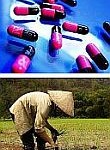Revisiting Red Yeast Rice Extract
 A while back, I reported on Red Yeast Rice Extract for cholesterol control. Since then, I was posed the question of, “If red yeast rice extract’s active ingredient is the exact same as a prescribed statin, then why do people who can’t tolerate their prescribed statin do well on it?”
A while back, I reported on Red Yeast Rice Extract for cholesterol control. Since then, I was posed the question of, “If red yeast rice extract’s active ingredient is the exact same as a prescribed statin, then why do people who can’t tolerate their prescribed statin do well on it?”
Well, that’s a good question that I didn’t have a ready answer for at the time. After some research and reflection, I’m willing to hazard a few guesses. Contained in this post is also a call for the supplement industry to standardize their Red Yeast Rice Extracts and to challenge the legal validity of the FDA’s regulation of products that naturally contain lovastatin.
The Statin Complex
The first statin to be marketed was lovastatin (Mevacor) which was approved in 1987 by the FDA and is also found in Red Yeast Rice Extract formulations.
Since then, the pharmaceutical companies have created a laundry list of statins:
- atorvastatin (Lipitor)
- fluvastatin (Lescol)
- pravastatin (Provachol)
- simvastatin (Zocor)
- cerivastatin (Baycol)
- rosuvastatin (Crestor)
Some of these are slightly chemically altered variations on lovastatin like simvastatin (Zocor) while others are radically different in chemical makeup and contain unnaturally occurring fluorine like rosuvastatin (Crestor).
Some of these are more problematic in producing side effects like muscle weakness and muscle breakdown otherwise known as rhabdomyolysis.
These statins can be divided into two groups: hydrophilic and lipophilic. This means that one group is more water soluble while the other is more fat soluble. The hydrophilic group seems in general, less problematic than the lipophilic ones.
One possible explanation for this is that the lipophilic group would have a greater potential to enter and linger in muscle tissue causing weakness and breakdown. Lovastatin is in the lipophilic class.
The motivation for producing these various forms of statins by the pharmaceutical companies is not necessarily to produce a better drug, but rather to slightly alter an existing one to obtain exclusive rights to market it. In other words, profit is the bottom line when it comes to producing different types of statins.
The Red Yeast Rice Extract (RYRE) Statin Complex
The statin compounds in RYRE are called monacolins of which there are fourteen. Monacolin K is the orginal name for lovastatin (Mevacor). The other monacolins have names like monacolin I through IV. All have similar, but slightly different chemical structures and do not contain flourine.
This rich mix of natural statins may offer a more efficient, less toxic form of cholesterol control than the single synthetic statin in pill form offered by pharmaceutical companies.
There are also sterols, isoflavones, and monounsaturated fatty acids in the extract which may also contribute to cholesterol control.
Maybe It’s in the Dose?
Pharmaceutical statins usually come in 10, 20 and 40 mg doses and are given in up to 80 mg/day.
A number of RYRE’s were tested for total monacolins and monacolin K (lovastatin). Total monacolins ranged from 0.3 mg to 11.5 mg with half being monacolin K. So maybe it is the lower dosage that makes it less troublesome to users.
Some users of pharmaceutical statins experience similar cholesterol control with fewer side effects when the dosage was reduced.
Statin research would suggest that taking more than the smallest dosage of 10 mg gives only moderate gains in cholesterol control with greater potential for adverse side effects (http://www.pmri.org/forum/showthread.php?t=249).
A Call for Red Yeast Rice Extract (RYRE) Standardization
The fact that the statins (monacolins) in RYRE vary widely calls for the industry to standardize this product. However, the supplement industry has had its hands tied in this respect because one of the ingredients is a patented pharmaceutical and thereby regulated by the FDA.
A while back, Swanson Health Products had their RYRE ordered to be pulled off the shelf because it contained lovastatin. Which is an endorsement of sorts.
Big Pharma traditionally avoids working with chemically unaltered compounds that naturally occur in plants since they can’t be patented.
How this naturally occurring compound became a patented prescription drug seems to violate all the regulatory laws and conventions.
Perhaps by standardizing RYRE to total monacolins without specific reference to monacolin K (lovastatin) the supplement industry could circumvent their problems with the FDA.
Both the FDA and the supplement industry should be working cooperatively to provide standardized RYRE that is free of citrinin, a toxic contaminate produced by a mold that can lead to kidney failure and of products spiked with prescription statins.
One should not get the idea that people taking RYRE haven’t experienced identical side effects to those taking conventional statins, however this is one more reason for the standardization of RYRE.

No Comments